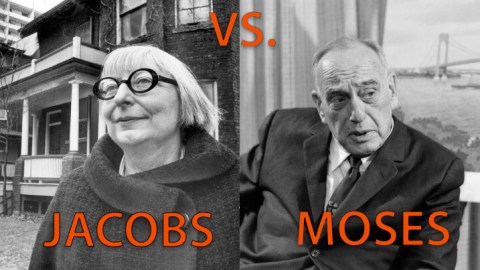Who Did New York Better? Jane Jacobs or Robert Moses?

Opera is arguably the most dramatic art form, and a new work titled A Marvelous Order (music by Judd Greenstein and libretto by Tracy K. Smith) takes one of New York’s most famous high-stakes duels and brings it to the stage. In the 1950s, a fierce battle raged between city planner Robert Moses and preservationist Jane Jacobs, a battle for the heart of New York. In NYC lore, Moses is a megalomaniac villain, giddy as he constructs the West Side Highway and destroys neighborhoods. Jacobs is the Batman, defender of Gotham, who protects Greenwich Village from Moses’ proposed Lower Manhattan Expressway (which would have gone right through Washington Square Park).
The two archetypal figures are perfect fodder for opera, although director Joshua Frankel is quick to point out that “we don’t want to make this Moses is Darth Vader and Jacobs is a perfect angel from heaven.” Making these people seem more like people, finding their faults and their redeeming qualities, is surely a more interesting and unexplored approach to the story. Jacobs wasn’t perfect, she was against the creation of Lincoln Center, which has been a legendary and prestigious part of the cultural scene in New York. And Moses, due to his refusal to build a new stadium for the Brooklyn Dodgers, is by de facto responsible for the creation of the New York Mets, which may be the only accomplishment of his for which I am truly and deeply grateful.
The 1980s saw the end of the Village, whose streets are now lined with boutiques, cupcake shops, NYU dorms, and brownstones only the very wealthy can afford.
A Marvelous Order is a work-in-progress that will be showing scenes at a gala November 2nd at the Sawdust in Williamsburg, Brooklyn. This is an interesting choice of venues, given the subject matter. Williamsburg is the latest in the line of artistic neighborhoods (predated by Greenwich Village, SoHo, and the Lower East Side) that have priced out their artists as the yuppie component staked their claim.
A decade later, SoHo went from being an artistic hub to the world’s largest outdoor shopping mall.
This was not a problem in Jacobs’ day, when artists could find affordable housing in Manhattan and build their communities there. The 1980s saw the end of the Village, whose streets are now lined with boutiques, cupcake shops, NYU dorms, and brownstones only the very wealthy can afford. A decade later, SoHo went from being an artistic hub to the world’s largest outdoor shopping mall. In the early-mid 2000s, Williamsburg was an enclave for artists of all types, as the warehouses provided enough space for whatever your project might be — a sculpture, a film set, a DIY concert venue. In 2015, it’s nearly impossible for those people to live in the neighborhood they created and there are now both a Starbucks and a J. Crew off of Bedford Avenue. What does this mean in the context of Moses vs. Jacobs?
Jacobs wanted to preserve artistic communities like the Village; Moses cared more about money. Moses fought public theater pioneer Joe Papp against the creation of free Shakespeare in the Park, and if alive today would probably live in a condo in Williamsburg. A Marvelous Order is bringing some of the art back to a neighborhood that has forgotten its very recent history, and will likely be one of the most riveting pieces of art this year. Bringing opera to North Brooklyn, telling a uniquely New York story, and humanizing two polarizing figures? That is a marvelous order, and this New Yorker can’t wait to watch the show.
What’s the state of architecture today? Paul Goldberger, architecture critic for The New Yorker magazine, weighs in.
—
Lori Chandler is a writer and comedian living in Brooklyn, NY. She has been published in The New York Times and on CollegeHumor. You can follow her on Twitter @LilBoodleChild to keep up with her latest pieces, performance dates, and wry observations.
WASHINGTON SQUARE PHOTO CREDIT: Nathan Blanley/Getty
FREEWAY PHOTO CREDIT: Apic/Hulton Archive





